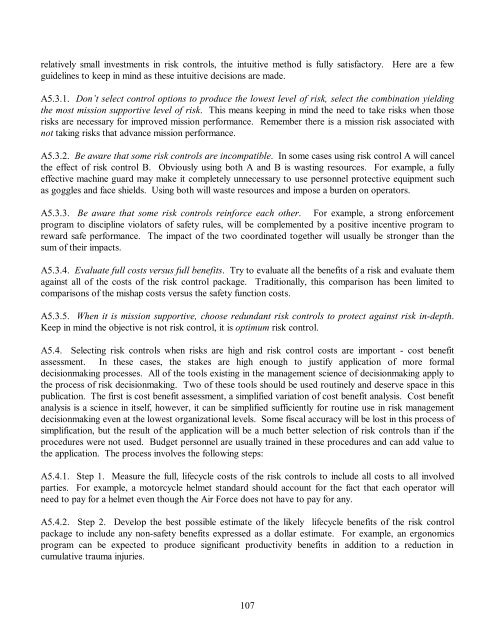BY ORDER OF THE AIR FORCE PAMPHLET 91-215 SECRETARY ...
BY ORDER OF THE AIR FORCE PAMPHLET 91-215 SECRETARY ...
BY ORDER OF THE AIR FORCE PAMPHLET 91-215 SECRETARY ...
Create successful ePaper yourself
Turn your PDF publications into a flip-book with our unique Google optimized e-Paper software.
elatively small investments in risk controls, the intuitive method is fully satisfactory. Here are a few<br />
guidelines to keep in mind as these intuitive decisions are made.<br />
A5.3.1. Don’t select control options to produce the lowest level of risk, select the combination yielding<br />
the most mission supportive level of risk. This means keeping in mind the need to take risks when those<br />
risks are necessary for improved mission performance. Remember there is a mission risk associated with<br />
not taking risks that advance mission performance.<br />
A5.3.2. Be aware that some risk controls are incompatible. In some cases using risk control A will cancel<br />
the effect of risk control B. Obviously using both A and B is wasting resources. For example, a fully<br />
effective machine guard may make it completely unnecessary to use personnel protective equipment such<br />
as goggles and face shields. Using both will waste resources and impose a burden on operators.<br />
A5.3.3. Be aware that some risk controls reinforce each other. For example, a strong enforcement<br />
program to discipline violators of safety rules, will be complemented by a positive incentive program to<br />
reward safe performance. The impact of the two coordinated together will usually be stronger than the<br />
sum of their impacts.<br />
A5.3.4. Evaluate full costs versus full benefits. Try to evaluate all the benefits of a risk and evaluate them<br />
against all of the costs of the risk control package. Traditionally, this comparison has been limited to<br />
comparisons of the mishap costs versus the safety function costs.<br />
A5.3.5. When it is mission supportive, choose redundant risk controls to protect against risk in-depth.<br />
Keep in mind the objective is not risk control, it is optimum risk control.<br />
A5.4. Selecting risk controls when risks are high and risk control costs are important - cost benefit<br />
assessment. In these cases, the stakes are high enough to justify application of more formal<br />
decisionmaking processes. All of the tools existing in the management science of decisionmaking apply to<br />
the process of risk decisionmaking. Two of these tools should be used routinely and deserve space in this<br />
publication. The first is cost benefit assessment, a simplified variation of cost benefit analysis. Cost benefit<br />
analysis is a science in itself, however, it can be simplified sufficiently for routine use in risk management<br />
decisionmaking even at the lowest organizational levels. Some fiscal accuracy will be lost in this process of<br />
simplification, but the result of the application will be a much better selection of risk controls than if the<br />
procedures were not used. Budget personnel are usually trained in these procedures and can add value to<br />
the application. The process involves the following steps:<br />
A5.4.1. Step 1. Measure the full, lifecycle costs of the risk controls to include all costs to all involved<br />
parties. For example, a motorcycle helmet standard should account for the fact that each operator will<br />
need to pay for a helmet even though the Air Force does not have to pay for any.<br />
A5.4.2. Step 2. Develop the best possible estimate of the likely lifecycle benefits of the risk control<br />
package to include any non-safety benefits expressed as a dollar estimate. For example, an ergonomics<br />
program can be expected to produce significant productivity benefits in addition to a reduction in<br />
cumulative trauma injuries.<br />
107
















